Arturia Microbrute User Manual
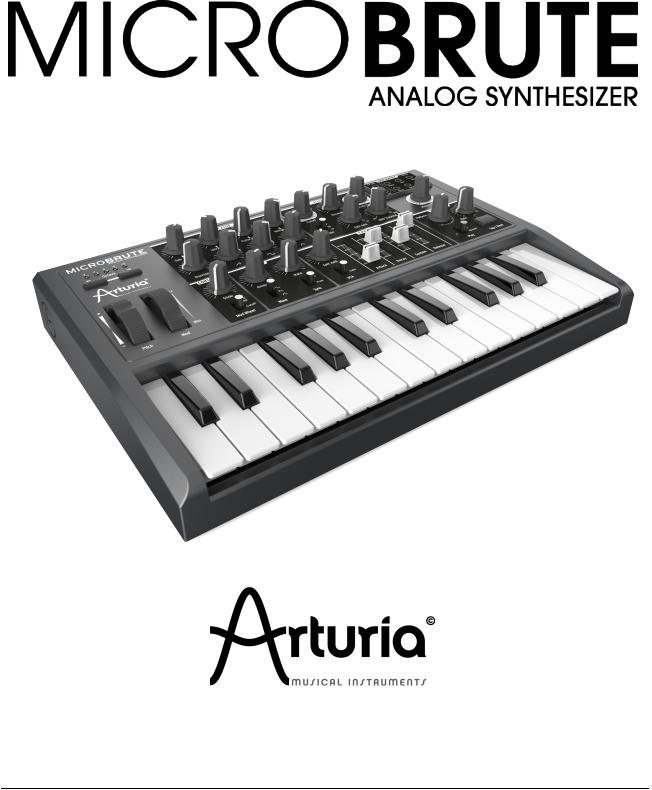
USER’S MANUAL
Arturia Microbrute User’s Manual |
1 |

PRODUCT AND PROJECT MANAGEMENT
Glen T. DARCEY
Bruno PILLET
ELECTRONICS
Yves USSON
Bruno PILLET
François BEST
Laurent BARET
Robert BOCQUIER
DESIGN
Axel HARTMANN (Design Box)
Morgan PERRIER
INDUSTRIALIZATION
Nicolas DUBOIS
MANUAL
Glen DARCEY
Morgan PERRIER
SPECIAL THANKS TO:
TABLE OF CONTENTS
Frank Orlich, Jean-Michel Blanchet, Michael Hosker, Sébastian Rochard, Boele Gerkes, Antonio Rodriguez, Katsunori Ujiie, Howard Jones, Alex Theakston, Jim Cowgill, Drew Anderson, Ray Barbee, Keith Shocklee, Kevin Lamb, Jim Norman, Ryan Wood.
1st edition: July 2013
Information contained in this manual is subject to change without notice and does not represent a commitment on behalf of ARTURIA. The hardware unit and the software product described in this manual are provided under the terms of a license agreement or non-disclosure agreement. The license agreement specifies the terms and conditions for its lawful use. No part of this manual may be produced or transmitted in any form or by any purpose other than purchaser’s personal use, without the explicit written permission of ARTURIA S.A. All other products, logos or company names quoted in this manual are trademarks or registered trademarks of their respective owners.
© ARTURIA S.A. 1999-2013, all rights reserved.
ARTURIA S.A.
30, chemin du vieux chêne 38240 Meylan
France http://www.arturia.com
Arturia Microbrute User’s Manual |
2 |

TABLE OF CONTENTS |
|
|
1 Introduction ....................................................................................................................... |
|
5 |
2 Installation.......................................................................................................................... |
|
9 |
Usage Precautions....................................................................................................................... |
|
9 |
Register your Instrument............................................................................................................ |
|
11 |
Connecting the MicroBrute to the World ................................................................................. |
11 |
|
Warm-Up and General Tuning.................................................................................................. |
13 |
|
3 Quickstart......................................................................................................................... |
|
14 |
Create your first sound: the “basic patch” .............................................................................. |
14 |
|
Introducing The Oscillator ......................................................................................................... |
|
15 |
More Oscillator options................................................................................................................... |
|
15 |
Combine sounds.............................................................................................................................. |
|
15 |
Introducing The Filter ................................................................................................................. |
|
16 |
Low Pass Filtering.............................................................................................................................. |
|
16 |
High Pass Filtering............................................................................................................................. |
|
16 |
Band Pass Filtering ........................................................................................................................... |
|
17 |
Filter Resonance............................................................................................................................... |
|
17 |
FILTER as an OSCILLATOR? ............................................................................................................. |
18 |
|
Brute Factor....................................................................................................................................... |
|
18 |
Introducing The Envelope ......................................................................................................... |
|
19 |
ENVELOPE TO VCA .......................................................................................................................... |
|
20 |
Introducing The LFO................................................................................................................... |
|
21 |
Introducing the Mod Matrix ...................................................................................................... |
22 |
|
Introducing The Sequencer ...................................................................................................... |
23 |
|
Recording A Basic Pattern............................................................................................................. |
23 |
|
Inserting Rests ................................................................................................................................... |
|
23 |
Moving On.................................................................................................................................. |
|
24 |
4 Synthesis Basics............................................................................................................... |
|
25 |
Analog synthesizer architecture............................................................................................... |
25 |
|
Oscillators................................................................................................................................... |
|
25 |
Signal Modifiers.......................................................................................................................... |
|
26 |
The Ultrasaw...................................................................................................................................... |
|
26 |
The Pulse Width Modulator ............................................................................................................ |
27 |
|
The Metalizer..................................................................................................................................... |
|
27 |
Filter............................................................................................................................................. |
|
28 |
What is a filter?................................................................................................................................. |
|
28 |
Filter types on MicroBrute: Low-pass, Band-pass, and High-pass .......................................... |
28 |
|
Resonance or emphasis................................................................................................................. |
29 |
|
Voltage Controller Amplifier ..................................................................................................... |
30 |
|
Modulators ................................................................................................................................. |
|
30 |
Low Frequency Oscillator (LFO).................................................................................................... |
31 |
|
Envelope Generator ....................................................................................................................... |
|
31 |
Human Interface ............................................................................................................................. |
|
32 |
5 Front Panel Features........................................................................................................ |
|
33 |
OSCILLATOR................................................................................................................................ |
|
33 |
The oscillator and its signal mixer ................................................................................................. |
33 |
|
Saw and Ultrasaw............................................................................................................................ |
|
33 |
Square and Pulse Width |
................................................................................................................. |
33 |
Triangle and Metalizer .................................................................................................................... |
|
34 |
The Overtone oscillator .................................................................................................................. |
|
34 |
Arturia Microbrute User’s Manual |
3 |
|

The Filter...................................................................................................................................... |
35 |
Filter Modes....................................................................................................................................... |
35 |
Cutoff ................................................................................................................................................. |
35 |
Resonance........................................................................................................................................ |
35 |
Brute Factor....................................................................................................................................... |
36 |
ENV Amt (envelope amount) ....................................................................................................... |
36 |
KBD Tracking ..................................................................................................................................... |
37 |
Envelope..................................................................................................................................... |
37 |
Envelope Amount............................................................................................................................ |
37 |
VCA switch........................................................................................................................................ |
37 |
Attack slide ....................................................................................................................................... |
38 |
Decay slider ...................................................................................................................................... |
38 |
Sustain slider...................................................................................................................................... |
38 |
Release slider.................................................................................................................................... |
38 |
Envelope Settings via the MicroBrute Editor .............................................................................. |
38 |
LFO .............................................................................................................................................. |
38 |
Wave Select...................................................................................................................................... |
39 |
Amount .............................................................................................................................................. |
39 |
Rate .................................................................................................................................................... |
39 |
Sync .................................................................................................................................................... |
39 |
LFO Settings via the MicroBrute Editor......................................................................................... |
39 |
Mod Wheel ................................................................................................................................. |
40 |
Mod to Cutoff................................................................................................................................... |
40 |
Mod to LFO Amt............................................................................................................................... |
40 |
Glide ........................................................................................................................................... |
40 |
Mod Matrix ................................................................................................................................. |
41 |
Modulations Sources....................................................................................................................... |
41 |
Modulation Destinations ................................................................................................................ |
41 |
General Controls........................................................................................................................ |
42 |
Keyboard........................................................................................................................................... |
42 |
Wheels................................................................................................................................................ |
42 |
Octave............................................................................................................................................... |
42 |
Master Volume................................................................................................................................. |
43 |
Sequencer.................................................................................................................................. |
43 |
Pattern ............................................................................................................................................... |
44 |
Play Mode ......................................................................................................................................... |
44 |
Rate .................................................................................................................................................... |
44 |
6 Rear panel ....................................................................................................................... |
46 |
Power supply.............................................................................................................................. |
46 |
USB .............................................................................................................................................. |
46 |
MIDI............................................................................................................................................. |
46 |
Audio In ...................................................................................................................................... |
47 |
Fine Tune..................................................................................................................................... |
47 |
Audio Outputs ............................................................................................................................ |
47 |
CV / GATE I/O ........................................................................................................................... |
47 |
Get MicroBrute Connection...................................................................................................... |
48 |
7 Legal Notes...................................................................................................................... |
49 |
No liability for consequential damages .................................................................................. |
49 |
FCC Information (USA) .............................................................................................................. |
49 |
Canada ...................................................................................................................................... |
50 |
Europe ........................................................................................................................................ |
50 |
Arturia Microbrute User’s Manual |
4 |
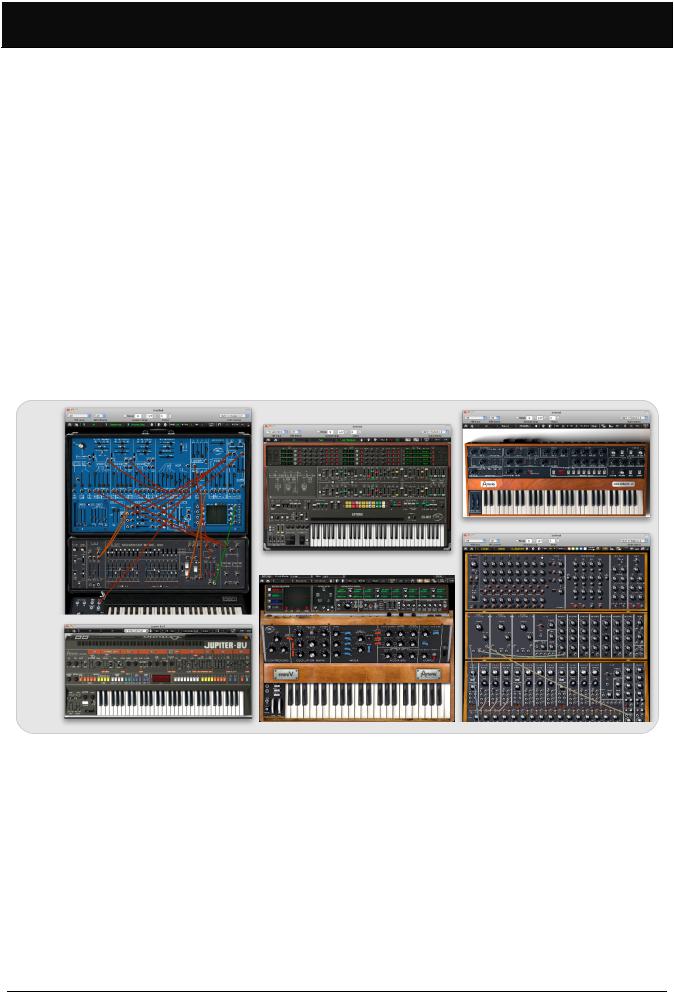
 1 Introduction
1 Introduction
Congratulations, and thank you for your purchase of the ARTURIA MicroBrute analog synthesizer.
The MicroBrute is based on the award winning analog designs of its big brother, the MiniBrute. The MiniBrute became a modern classic by bringing excellent sound quality, user features and craftsmanship to the market with a price point that no others were able to match. The MicroBrute builds on this legacy and is designed to be another modern classic for anyone from the first time synth buyer to the experienced pro with a studio full of gear.
Since the late 1990s, ARTURIA has received acclaim from players and reviewers alike for designing state-of-the-art software emulations of the venerable analog synthesizers from the 1960s to the 1980s. From the Modular V, back in 2004, to Origin, a modular system of a new generation that we introduced in 2010; from Analog Factory Experience, the first hybrid synthesizer ever (debuted in 2008), to the Oberheim SEM V released at the end of 2011, our passion for synthesizers and sonic purity has given demanding musicians the best software instruments for professional audio production.
SOFTWARE
Arturia Microbrute User’s Manual |
5 |
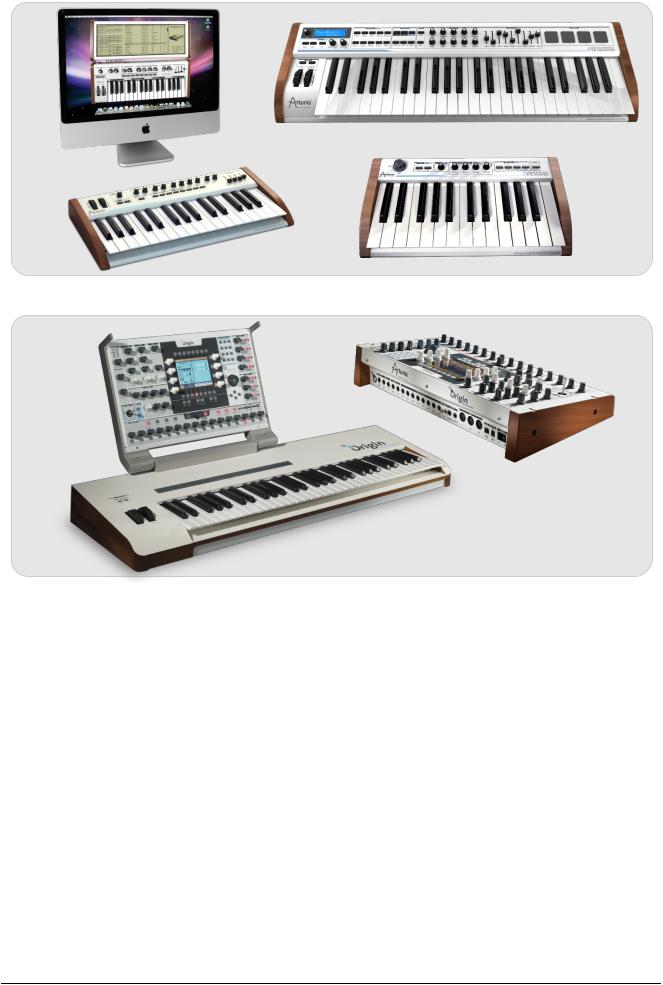
HYBRID
HARDWARE
Overview of some of ARTURIA’s software, hardware and hybrid instruments
After recreating so many legendary analog synthesizers by translating these classic instruments into sophisticated DSP algorithms, the time was right for ARTURIA to introduce an analog synth of its own, the MiniBrute. But reproducing analog circuitry is not the same as designing great-sounding analog circuits, so we enlisted the aid of Yves USSON
— an extremely talented analog circuit designer and synthesizer enthusiast whose work spans three decades.
Besides being a talented researcher in bio-molecular microscopy, his clones of the modules originally designed by Bob Moog, as well as ARP or EMS and his own designs, are highly renowned in the “modular” world and continuously produced under license by specialty manufacturers.
Arturia Microbrute User’s Manual |
6 |

What’s more, he’s always willing to share his considerable experience, and pass along his knowledge to others. All his schematics stay open to the D.I.Y.1 community; most of his works can be found on the “Yusynth” project website2, and he casts a long, and welcome, shadow on the major Internet forums devoted to analog fanatics.
Yves USSON and a couple of wired friends
Combining ARTURIA’s acclaimed savoir-faire in designing innovative musical instruments, and Yves’ deep knowledge and experience, both the MiniBrute and MicroBrute analog synthesizers have their roots in the 1970s yet incorporates the best of the 21st century.
1 D.I.Y. = “Do It Yourself”
2 http://yusynth.net
Arturia Microbrute User’s Manual |
7 |
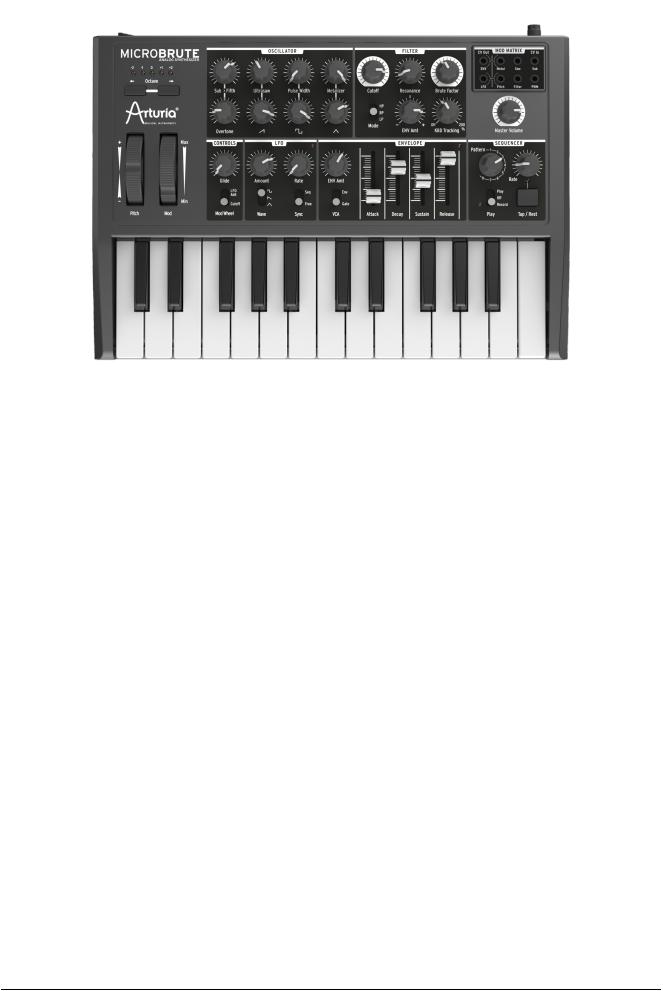
We built the MicroBrute with the idea that many people need an easy to use synth for live and studio purposes. But an easy to use synth must still retain excellent sound quality and enough features to keep a sound designer busy for years. It is true that MicroBrute is simple to use and allows anyone to tweak sounds and make music without having to delve too deep into synthesis but it does not mean that the experienced user will not be impressed with the sound possibilities that this little powerhouse has.
The pure analog oscillators with the newly designed OVERTONE PLL offer more raw tone generation options than many synthesizers in the $1000+ price range.
The multimode Steiner-Parker filter is the same design that is found on the MiniBrute. The inventor, Nyle Steiner himself looked over our design and gave his stamp of approval. Many synthesizers with large price tags only give you one filter mode; MicroBrute gives you three. Add the MOD MATRIX patch bay, the multi wave LFO, USB, MIDI and CV/Gate interfaces and the exciting new STEP SEQUENCER and you have a product that meets or exceeds any other synthesizer in this price range, EVER!
MicroBrute is all about top shelf sound quality, but with a musical interface that will not intimidate and a price that will not break the bank.
MicroBrute is truly a musical instrument. We loved designing it, building it, and now, playing it. We hope you will share our enthusiasm, and find inspiration in its sounds.
Arturia Microbrute User’s Manual |
8 |

 2 Installation
2 Installation
Usage Precautions
The MicroBrute uses an external power adapter. Do not use any power supply or adapter other than the one provided by Arturia and specified in this manual. ARTURIA accepts no responsibility for damage caused by use of an unauthorized power supply.
WARNING
Do not place this product in a place or position where one might walk on, trip over, or roll anything over power cords or connecting cables.
The use of an extension cord is not recommended. However if you must use one, make sure that the cord has the ability to handle the maximum current needed by this product. Please consult a local electrician for more information on your power requirements.
This product should be used only with the components supplied or recommended by ARTURIA. When used with any components, please observe all safety markings and instructions that accompany the accessory products.
SPECIFICATIONS SUBJECT TO CHANGE
The information contained in this manual is believed to be correct at the time of printing. However, ARTURIA reserves the right to change or modify any of the specifications without notice or obligation to update existing units.
IMPORTANT
Always follow the basic precautions listed below to avoid the possibility of serious injury or even death from electrical shock, damages, fire or other risks.
The product used either alone or in combination with an amplifier, headphones or speakers, may be able to produce sound levels that could cause permanent hearing loss. DO NOT operate for long periods of time at a high level, at a level that is uncomfortable, or a level that exceeds prevailing safety standards for hearing exposure. If you encounter any hearing loss or ringing in the ears, consult an audiologist immediately. It is also a good idea to have you ears and hearing checked annually.
Arturia Microbrute User’s Manual |
9 |

NOTICE
•Use only the provided AC adapter, as specified by ARTURIA.
•Read and understand all the instructions.
•Always follow the instructions on the instrument.
The manufacturer’s warranty does not cover service charges incurred due to a lack of knowledge relating to how a function or feature works (when the unit is operating as designed); reading the manual is the owner's responsibility. Please study this manual carefully and consult your dealer before requesting service.
PRECAUTIONS INCLUDE, BUT ARE NOT LIMITED TO, THE FOLLOWING:
•Before cleaning the instrument, always remove the electrical plug from the outlet, as well as the USB cable. When cleaning, use a soft and dry cloth. Do not use gasoline, alcohol, acetone, turpentine or any other organic solutions; do not use liquid cleaner, spray or cloth that’s too wet.
•Do not use the instrument near water or moisture, such as a bathtub, sink, swimming pool or similar place.
•Do not place the instrument in an unstable position where it might accidentally fall over.
•Do not place heavy objects on the instrument. Do not block openings or vents of the instrument; these locations are used for ventilation to prevent the instrument from overheating.
•Do not place the instrument near a heat vent or any place of poor air circulation.
•Make sure the line voltage in your location matches the input voltage specified on the AC power adapter.
•Do not open and insert anything into the instrument, as this could cause a fire or electrical shock.
•Do not spill any kind of liquid onto the instrument.
•In the event of a malfunction, always take the instrument to a qualified service center. You will invalidate your warranty if you open and remove the cover, and improper testing may cause electrical shock or other malfunctions.
•Do not use the instrument when thunder and lightning is present.
•Do not expose the instrument to hot sunlight.
•Do not use the instrument when there is a gas leak nearby.
•ARTURIA is not responsible for any damage or data loss caused by improper operations to the instrument.
•ARTURIA recommends the use of shielded and less than 3 meters long cables for Audio, and ferrite equipped CV/Gate and USB cables.
Arturia Microbrute User’s Manual |
10 |
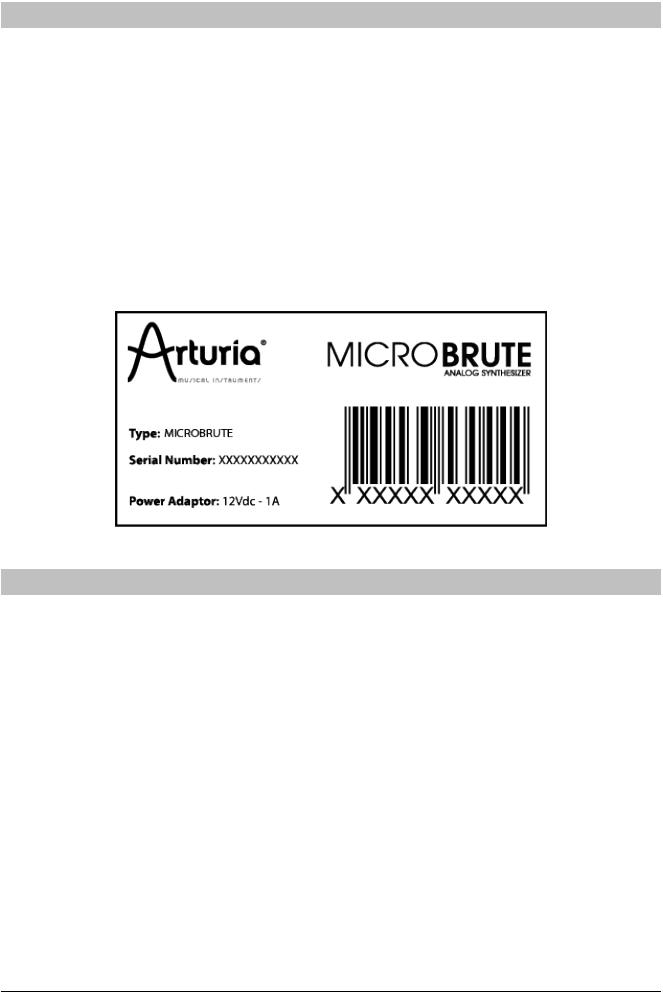
Register your Instrument
Registering your instrument establishes your legal ownership, which entitles you to access the Arturia Technical Support service, and be informed of updates.
Additionally, you can subscribe to the ARTURIA newsletter to be informed of ARTURIArelated news as well as promotional offers.
Connect to your Arturia account via this URL: http://www.arturia.com/login If you do not have an account, create a new one.
Once you have your account and are logged in, go to the section “My Registered Products”, and add the MicroBrute synthesizer by entering its serial number, as printed on the sticker located under the machine:
Connecting the MicroBrute to the World
Always power-off all audio gear before making any connections. Failing to do so may damage your speakers, the MicroBrute synthesizer, or other audio equipment.
After completing all connections, set all levels to 0. Power on the various devices, with audio amplifier or monitoring system last, then raise the volumes to a comfortable listening level.
Arturia Microbrute User’s Manual |
11 |
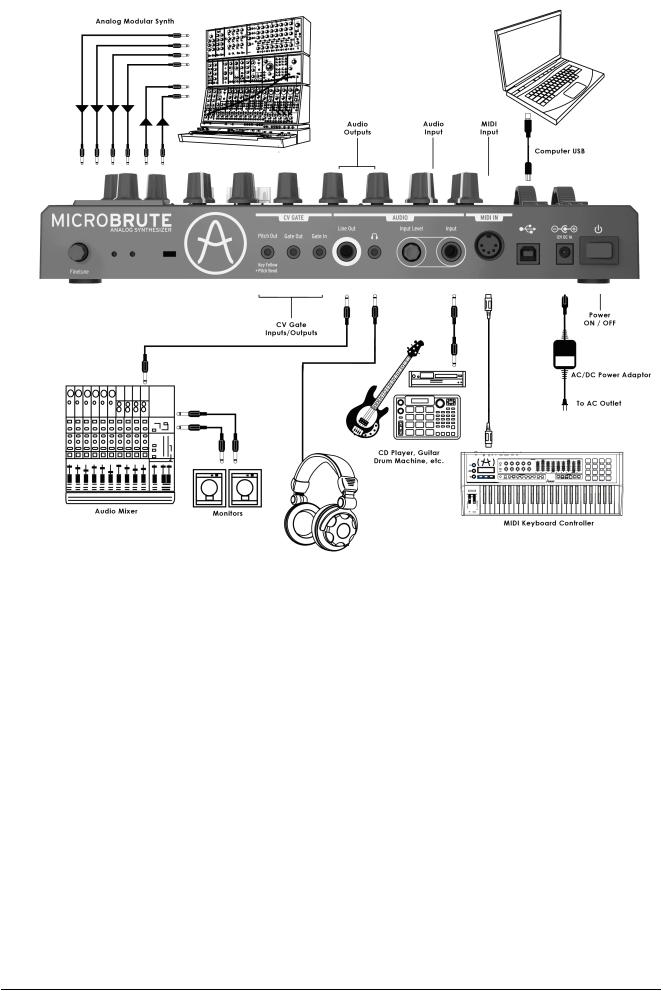
Here is an overview of the MicroBrute synthesizer’s connectors:
• |
Audio Input & Outputs |
..........6.35 mm (1/4'') mono jacks |
•Headphone Output…………3.5 mm (1/8'') miniature stereo jack
• |
CV/Gate................................. |
3.5 mm (1/8'') miniature mono jacks |
• |
MIDI Input................................ |
Standard MIDI DIN-5 |
• |
USB........................................... |
Standard USB type B |
• |
Power DC Input...................... |
12 Volt, 1Amp, Center pin positive |
Arturia Microbrute User’s Manual |
12 |

Warm-Up and General Tuning
As with all true analog synthesizers, after being powered-on the MicroBrute needs a warm-up period of approximately five to ten minutes.
This allows the oscillator to reach a stable operating temperature, which insures accurate oscillator pitch. Warm-up time depends on the external temperature; a colder ambient temperature will require longer warm-up times, while a hotter ambiance will result in shorter times.
Once the synthesizer has reached its running temperature, tune it to pitch. Use an external tuner to check the instruments tuning; if needed, tweak the Fine Tune knob on the rear panel to tune the MicroBrute to the desired pitch.
The MicroBrute has been designed for rock-solid pitch stability when operated in normal temperature and humidity conditions, at external temperatures between 20°C and 32°C in temperate areas. In practice, the MicroBrute provides satisfactory operation over a much wider temperature range, although extreme external temperatures or fluctuations can lead to longer stabilization time or erratic tuning.
Arturia Microbrute User’s Manual |
13 |
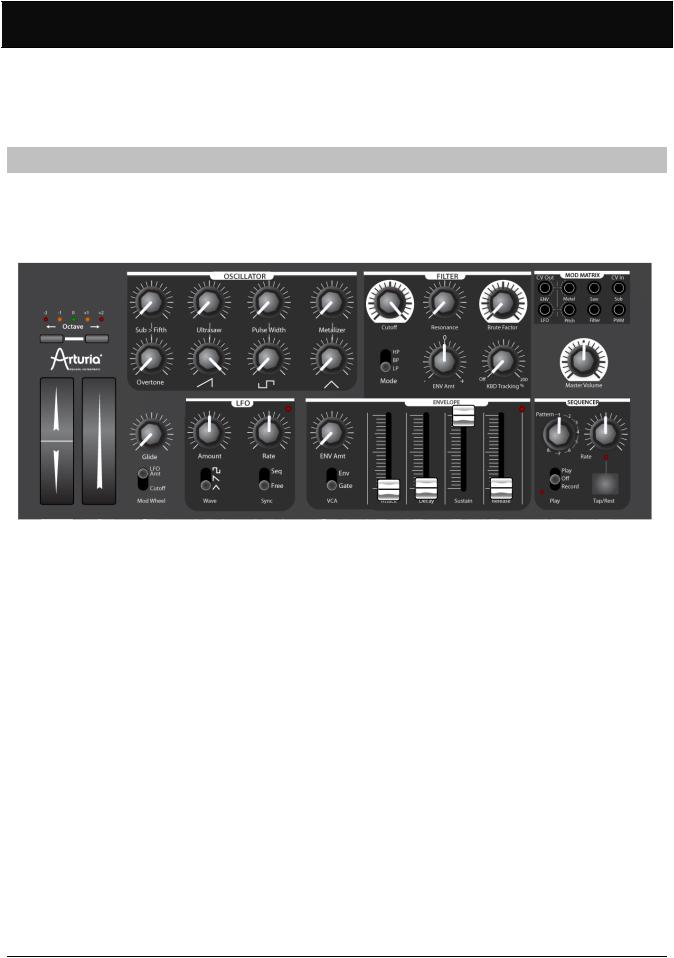
 3 Quickstart
3 Quickstart
This chapter provides the basic instruction that you will need to create your very first sounds with the MicroBrute. In subsequent chapters, we’ll get deeper into the sound design process so you can create more animated and complex sounds.
Create your first sound: the “basic patch”
Once your MicroBrute has been correctly connected to your sound system, set all the controls to the positions shown in Figure 1. This is going to be referenced many times over as the BASIC PATCH.
Figure 1
Switch on your MicroBrute, there will be about a 5 – 10 second time with no sound. Once it is booted up, let it warm up to stabilize the pitch. You can of course use it before it is warmed up but the pitch WILL drift for the first few minutes.
These settings (also called a PATCH) are very useful. This patch makes a good reference point to start doing sound design. Remember it and refer to it often. This will help you gain a better understanding of what each control does and how they interact with each other so that you will grow more rapidly in your skills.
Now try playing some notes and listen to the sound. The sound of the basic patch is just that; BASIC. What you are hearing is the raw SAWTOOTH WAVE from the OSCILLATOR.
Arturia Microbrute User’s Manual |
14 |

Introducing The Oscillator
The oscillator is the tone-generating center of the MicroBrute. The basic patch has the Sawtooth Wave turned up fully. Try turning the Sawtooth Wave down to 0 and turning up the Square Wave as shown in Figure 2
Figure 2
You will hear the sound go from a brighter, buzzy sound to a more rounded and hollow tone.
Now try turning the Square Wave down and turn up the Triangle Wave. The sound will be even darker now.
Turn the Triangle Wave down and turn up the Overtone level and listen to it.
More Oscillator options
The knobs directly above each of the waveform level knobs, adjust aspects of the sound of each waveform itself. Turn up one waveform level at a time and then try turning the knob directly above to hear how the sound changes. You can hear how varied the sounds can be.
Combine sounds
Now try turning up more than one level knob and mixing the sounds of different waveforms together. When you start mixing waveforms and adjust the wave modifiers above them, you start to hear the great variation of sounds that you can generate on the MicroBrute.
Arturia Microbrute User’s Manual |
15 |
